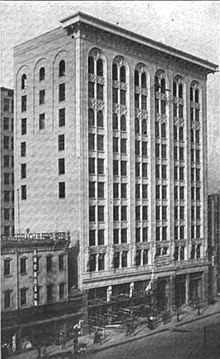Kearns Building
Kearns Building | |
 Kearns Building, May 2019 | |
| Location | 132 South Main Street Salt Lake City, Utah United States |
|---|---|
| Coordinates | 40°45′58″N 111°53′27″W / 40.76611°N 111.89083°W |
| Area | 0 acres (0 ha) |
| Built | 1909 |
| Built by | George Curley |
| Architect | Parkinson & Bergstrom |
| Architectural style | Late 19th And Early 20th Century American Movements, Sullivanesque |
| MPS | Salt Lake City Business District MRA |
| NRHP reference No. | 82004145[1] |
| Added to NRHP | August 17, 1982 |
The Kearns Building is a historic office building in Salt Lake City, Utah, United States, that is listed on the National Register of Historic Places (NRHP).[1]
Description

The 10-story building was designed by Los Angeles architects John Parkinson and George Bergstrom and constructed 1909–1911. Parkinson & Bergstrom borrowed the style of architect Louis Sullivan, and the Kearns Building has been described as Sullivanesque, with a steel reinforced concrete frame and a white terracotta tile facade emphasizing vertical piers below a prominent cornice. The building was added to the National Register of Historic Places in 1982.[2]
The style of a Louis Sullivan skyscraper was built on classical form, with prominent window and door openings at street level, bands of windows between vertical piers, and a distinctive, highly decorated cornice. Often Sullivan designed porthole windows under a cornice.[3] Parkinson & Bergstrom used centered medallions between spandrels recessed behind the plane of piers to achieve a similar appearance.[2]
The Kearns Building was named for Thomas Kearns, a wealthy former Utah senator and major stockholder in The Salt Lake Tribune. During construction of the building, Kearns was accused of manipulating the city council and its building code.[4]
A third of office space in the building was rented prior to opening in February, 1911,[5] and most of the offices were rented by April of that year.[6] Early tenants of the building included clothiers Gardner & Adams Co.[7] and Rowe & Kelly,[8][9] and the building included what was billed as "the most beautiful buffet in the United States," the Mecca.[10]
See also
- National Register of Historic Places listings in Salt Lake City
- Aberdeen Quarry, the source of granite used for the first-floor columns and entrance archway
- Chicago school (architecture)
References
- ^ a b "National Register Information System". National Register of Historic Places. National Park Service. November 2, 2013.
- ^ a b "National Register of Historic Places Inventory/Nomination: Kearns Building". National Park Service. Retrieved May 12, 2019. With accompanying pictures
- ^ "Sullivanesque Style 1890 - 1930". Pennsylvania Historical & Museum Commission. Archived from the original on April 22, 2019. Retrieved May 11, 2019.
- ^ "Above the Law's Power". The Salt Lake Harold-Republican. Salt Lake City, Utah. November 7, 1910. p. 11. Retrieved May 11, 2019.
- ^ "Tenants for Kearns Building". The Salt Lake Tribune. Salt Lake City, Utah. January 29, 1911. p. 14. Retrieved May 11, 2019.
- ^ "Speakers at Feast Suggest Architects for New Capitol". The Salt Lake Tribune. Salt Lake City, Utah. April 18, 1911. p. 14. Retrieved May 11, 2019.
- ^ "Grand Opening: Gardner & Adams Co.,". Salt Lake Tribune. Salt Lake City, Utah. December 18, 1910. p. 9. Retrieved May 11, 2019.
- ^ "The opening of the beautiful new store of Rowe & Kelly..." Goodwin's Weekly. Salt Lake City, Utah. March 18, 1911. p. 8. Retrieved May 11, 2019.
- ^ Rowe & Kelly soon consolidated with Mullet Clothing Company as the Mullet-Kelly Co. See The Clothier and Furnisher. Vol. 80. George N. Lowry Company. 1912. p. 93. Retrieved May 11, 2019.
- ^ "The Mecca in the New Kearns Building". The Salt Lake Tribune. Salt Lake City, Utah. April 30, 1911. p. 32. Retrieved May 11, 2019.
Further reading
- "Kearns Building", Goodwin's Weekly, December 17, 1910, pp 47
External links
![]() Media related to Kearns Building (Salt Lake City) at Wikimedia Commons
Media related to Kearns Building (Salt Lake City) at Wikimedia Commons




